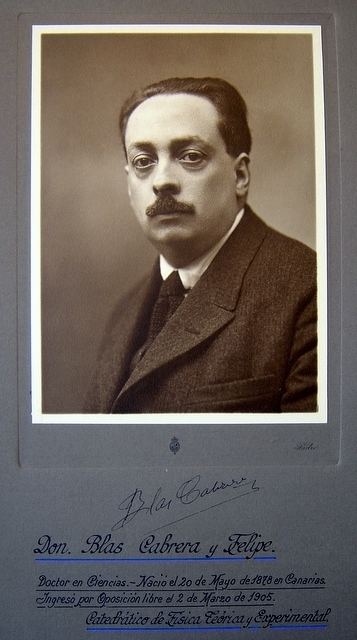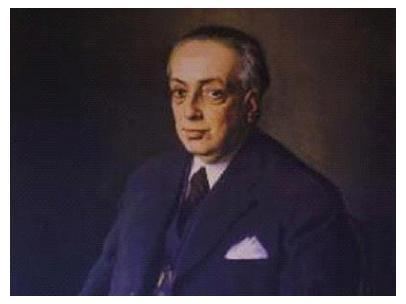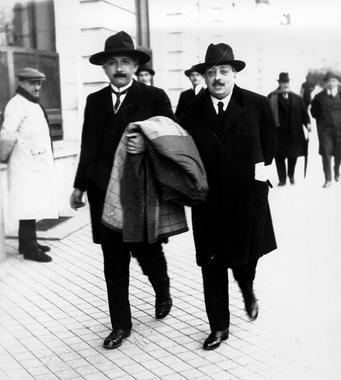Name Blas Felipe Children Nicolas Cabrera | Role Physicist Grandchildren Blas Cabrera | |
 | ||
Died August 1, 1945, Mexico City, Mexico Education Complutense University of Madrid | ||
Lipdub ies blas cabrera felipe abril 2012
Blas Cabrera y Felipe (1878 in Arrecife, Lanzarote – August 1, 1945 in Mexico DF) was a Spanish physicist.
Contents

Biography

Cabrera received his baccalaureate in La Laguna (Tenerife, Spain). He then moved to Madrid where he began studying law, following family tradition. He met at that time Santiago Ramon y Cajal, who convinced him to abandon law and study science. He graduated from the Universidad Central de Madrid (present day Complutense University of Madrid) in Physics and Mathematics, earning a doctorate in Physics in 1901.

He was an experimental physicist, and developed his interests mostly in the field of magnetic properties of matter, achieving a prominent position among the physicists of his era. In 1903 he participated in the foundation of the Spanish Society of Physics and Chemistry and the annals of that society. In 1905, he obtained the chair of Electricity and Magnetism in the Universidad Central. He married Maria Sanchez Real in 1909. In 1910, the Junta de Ampliacion de Estudios created the Laboratorio de Investigaciones Fisicas, of which Cabrera was appointed as director. The Laboratory had five lines of investigation: magnetochemistry, physical chemistry, electrochemistry, electroanalysis and spectroscopy, and contributed greatly to the research and development of physics in Spain. With a grant from the Junta de Ampliacion de Estudios (1912), Cabrera visited several European research centers including the Physics Laboratory of the Politechnic of Zurich (directed by Peter Weiss), in which he carried out experiments in magnetochemistry. He also visited the physics laboratories of the universities of Geneva and Heidelberg, and the International Bureau of Weights and Measures in Paris.

On returning to Spain, Cabrera used the techniques he had learned during his European tour, especially those developed in the Zurich laboratory, to continue his research on magnetism, in collaboration with other researchers such as Enrique Moles Ormella and Arturo Duperier.
Cabrera's research work was prolific. Between 1910 and 1934 he published about 110 works (Peter Heiss, then director of Strasbourg University's Physics Institute, commented in 1932 that among the 180 articles about magnetism present in the institute's library, 24 came from the Laboratorio de Investigaciones Fisicas which Cabrera directed). He interpreted magnetization curves in terms of the Weiss magneton. He modified Curie-Weiss's law, which describes the magnetic susceptibility of a ferromagnetic material in the paramagnetic region beyond Curie point, and deduced an equation to describe an atom's magnetic moment taking into account the effect of temperature.
At the same time, he improved many experimental devices. He was the first scientist in Spain to use the methods of the theory of errors and of the least squares for the determination of physical constants. Some of his measures of magnetic susceptibility continue to be the most precise in existence.
However, his work was not solely investigation. He was also a great publisher and disseminator of modern theories of physics that were defined in the first thirty years of the 20th century. Thus, in 1912 he published an article in the magazine Real Academia de Ciencias Exactas, Fisicas y Naturales titled "Fundamental principles of vectorial analysis in three-dimensional space and in Minkowski space" ("Principios fundamentales del analisis vectorial en el espacio de tres dimensiones y en el Universo de Minkowski"). Along with the review published in 1912 by Esteban Terradas of Max von Laue's book Das Relativitatsprincip, which had appeared the previous year, these works were meant to introduce the special theory of relativity to Spain.
Cabrera's work was also recognized on an international level. Cabrera was host to Albert Einstein during his visit to Spain in 1923. In 1928 he became a member of the French Academy of Sciences, sponsored by physicists Paul Langevin and Maurice de Broglie. That year he received the greatest recognition of his whole career: at the request of Einstein and Marie Curie, Cabrera was named a member of the 6th Scientific Committee of the Solvay Conference. These conferences, held triannually, brought together the world's finest physicists. In the Solvay Conference of 1930, Cabrera participated with a paper titled "The magnetic properties of matter."
In 1931 Cabrera was named director of the Universidad Central de Madrid. A year later, along with other scientists such as Miguel A. Catalan and his disciple, Julio Palacios, he pushed for the creation of the National Institute of Physics and Chemistry with the aid of a donation from the Rockefeller Foundation, and placed at the building known as the "Rockefeller building" at Serrano Street in Madrid. (Today the Rocasolano Chemical-Physics Institute, of the Spanish National Research Council, is located there.)
In 1931, Cabrera replaced Leonardo Torres Quevedo, who had abandoned his post due to health problems, at the International Bureau of Weights and Measures. In 1933 he participated in the creation of the Summer International University of Santander (now the Universidad Internacional Menendez Pelayo), being called as its director the following year. In 1936, he was in Santander at the outbreak of the Spanish Civil War. He went to France, and from there returned to Madrid. In 1937, the president of the International Bureau of Weights and Measures, Pieter Zeeman, named him secretary of that bureau, a post that would occupy him between 1937 and 1941, and he went to live to Paris. Nevertheless, after the end of the war, the Franco government demanded that he leave the post, even though the position had no representative value with respect to Spain. Cabrera resigned and went into self-exile in Mexico, where he was welcomed by the Faculty of Sciences at the Universidad Nacional Autonoma de Mexico, in which he became a Professor of Atomic Physics and History of Physics. In 1944 he began to direct the magazine Ciencia, edited by exiled Spanish scientists; after Cabrera's death the post passed to Ignacio Bolivar. In this same year, the Spanish Cultural Institution of Buenos Aires published his last work, El magnetismo de la materia. He died in exile in Mexico in 1945.
Positions
Cabrera held several positions and belonged to numerous institutions: member and president of the Real Academia de Ciencias Exactas, Fisicas y Naturales, member of the Real Academia Espanola (where he occupied the chair of his friend and teacher Santiago Ramon y Cajal), president of the Sociedad Espanola de Fisica y Quimica, director of the Laboratory of Physics Investigations (of the Junta para Ampliacion de Estudios), director of the Instituto Nacional de Fisica y Quimica, foreign member of the French Academy of Sciences, member of the Scientific Committee of the 6th Solvay Conference of 1930 (Brussels), director of the Universidad Central de Madrid and of the Universidad Internacional Menendez Pelayo, and secretary of the International Bureau of Weights and Measures in Paris.
